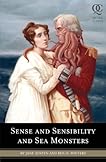 Stitches: A Memoir by David Small
Stitches: A Memoir by David SmallMy rating: 4 of 5 stars
In general, I’m not big on unhappy-childhood memoirs. Despite Tolstoy’s dictum, the genre is awfully repetitive, and often of dubious literary merit. Having had alcoholic parents or a drug problem or a Hardscrabble Existence Full of Simple Joys Not Like These Kids Today With Their Texting and Whatnot—it makes you deserving of sympathy, sure, but it doesn’t make you a *writer*. And the market is certainly glutted. It is probably a good thing, then, that I didn’t bother to read the blurbs on the back of David Small’s graphic memoir Stitches (which include the word “redemptive,” ick). Because it’s about an unhappy childhood, and it’s great.
The central trauma of Small’s young life was an operation at fourteen that he thought was simply to remove a cyst on his neck; he awoke missing a vocal cord, with a lurid incision stretching up his throat, “slashed and laced back up like a bloody boot.” He has to relearn speech. He is not supposed to learn, but does, that he had thyroid cancer, brought on by his radiologist father’s overzealous use of X-rays in an attempt to cure his sinus problems. His mother is cold, his father distant and preoccupied, his grandmother actively insane. It’s a harrowing tale, buoyed up by a formidable artistic talent.
Small is best known as a children’s book illustrator (he’s got a couple of lively sketches up in Watermark’s basement autograph gallery, in fact), a Caldecott winner in 2001 for Judith St. George’s So You Want to Be President?. His drawing style reminds me of Jules Feiffer’s illustrations in The Phantom Tollbooth, loose-jointed, often suggestive instead of precise, by turns whimsical and haunting. Stitches is entirely black and white, and here my vocabulary falters: I am not sure what to call the shading technique he uses. It looks like watercolor, but all in greys, a paintbox of ashes and thunderheads, punctuated with inky slashes. Just the two pages where we see his basted wound for the first time are a textbook in murk and exactitude, the variegated non-colors of blood and bruise receding from the bleached sutures, an unnatural imprint of disease and deception.
Graphic works require new skills: how do you read pictures? How long do you look at a page with no text before turning it? Memoir, too, provokes questions: is the story better somehow because true?
 Sense and Sensibility and Sea Monsters by Ben H. Winters
Sense and Sensibility and Sea Monsters by Ben H. Winters
My rating: 4 of 5 stars
When Quirk Classics’ first literary mash-up, Pride & Prejudice & Zombies, came out earlier this year, we Austen-obsessed Watermarkers kept it displayed close at hand, for the sheer delight of watching customers’ reactions to its cover, which features a well-coiffed Regency lass missing several important parts of her face. As one might gather, comments fell into two camps: the “That is the most horrible thing I’ve ever seen!” variety, and, like my own, “That may be the single greatest idea anyone has ever had!” (Take that, penicillin and the wheel!) It seems the general populace leaned towards the latter, because P&P&Z has been hanging out on the New York Times bestseller list for months now. Last I heard, the movie rights were in hot contention. May I suggest, Hollywood, that no one could pull off Mr.-Darcy-as-action-hero better than Clive Owen?
Sense & Sensibility & Sea Monsters mines the same vein, with gleeful results. You see, some time before the action takes place, a horrible change took place in the oceans of the world; known as the Alteration, this mysterious event turned all the creatures of the sea into vicious monsters, bent on destroying mankind. Needless to say, this left England, being mostly coast, rather susceptible to attack by sea serpents, gargantuan jellyfish, razor-toothed crawfish, and the like. It’s a downright Lovecraftian premise, crossed with a little H. Rider Haggard (in a subplot about young Margaret Dashwood’s glimpses of an alien geyser-worshipping civilization on the secluded island where Barton Cottage stands).
And where is Austen in all this? Well, Sense & Sensibility & Sea Monsters has, despite appearances, the same basic plot as its more respectable namesake, and in fact, many of the same words. What’s brilliant about these two Austen-horror hybrids is actually their fidelity to the originals—I think most of the humor would be lost on someone who hadn’t read the non-zombified-and-sea-monstered versions. For instance, in the parody, poor Colonel Brandon is not only old (at 35) and less than dashing: he’s been cursed by a sea witch, and the bottom half of his face is covered with tentacles. Thus, in the early conversation between Willoughby and Marianne over their shared dislike of him, Austen’s words get oh-so-subtly spun: “‘Brandon is just the kind of man,’ said Willoughby, ‘whom everybody speaks well of, and nobody cares about; whom all are delighted to see, and everybody is sort of mildly afraid to look at him directly.’”
I can, of course, understand why Austen purists object. Sense & Sensibility & Sea Monsters, and its predecessor, are thoroughly silly exercises in subversion. Me, I think they’re hilarious. As for what Quirk Classics should tackle next, I’m torn: Northanger Abbey is begging for a vampire or two, but giant robots would liven up Mansfield Park considerably, wouldn’t they?








No comments:
Post a Comment